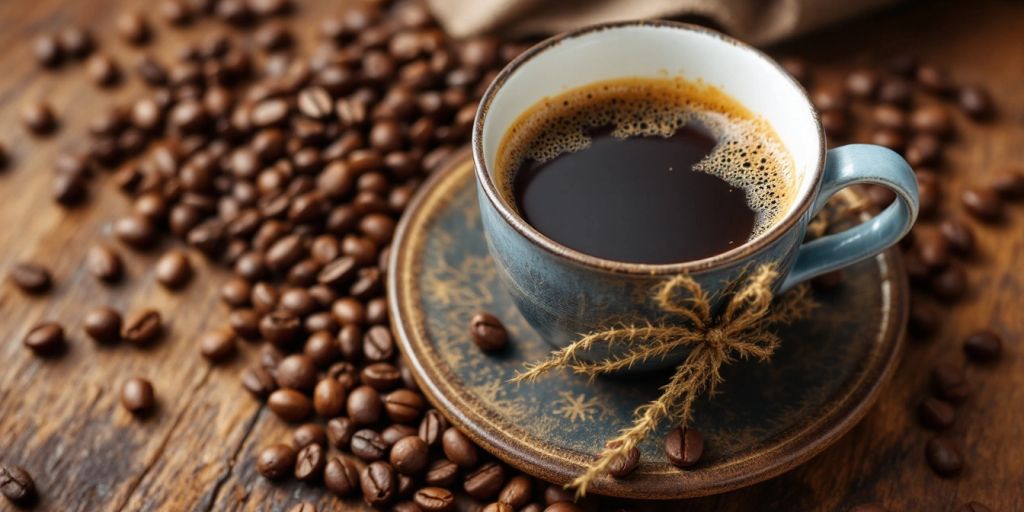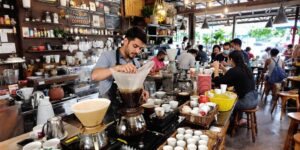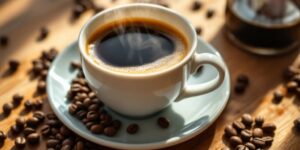Coffee brewing is more than just a morning pick-me-up; it’s a skill that can make your coffee experience truly special. Whether you’re a beginner or have been brewing for a while, understanding the fundamentals can help you create the perfect cup. Here are some key takeaways to guide you on your coffee journey.
Key Takeaways
- Start with high-quality, fresh coffee beans for the best flavor.
- Use the right grind size for your brewing method to enhance extraction.
- Measure your coffee and water accurately to find your perfect strength.
- Keep your brewing equipment clean to avoid bad tastes.
- Experiment with different brewing methods and flavors to find what you love.
Choosing the Right Coffee Beans
When it comes to brewing a fantastic cup of coffee, the right beans make all the difference. Here’s how to choose coffee beans that will elevate your coffee experience:
Understanding Coffee Bean Varieties
- Arabica: Known for its smooth, complex flavors.
- Robusta: Stronger, more bitter taste, often used in espresso.
- Liberica: Unique fruity and floral notes, less common.
Selecting Freshly Roasted Beans
- Look for uniformity in bean size; this is a key indicator of a quality roast.
- Check the roast date; fresher beans mean better flavor.
- Buy in small batches to ensure you always have fresh coffee.
Sourcing Ethical and Sustainable Beans
- Choose brands that prioritize sustainability and fair trade.
- Look for certifications like Rainforest Alliance or Fair Trade.
- Support local roasters who focus on ethical sourcing.
Remember, the journey to great coffee starts with the beans you choose. Explore different varieties and find what excites your palate!
Mastering the Grind
Importance of Grind Size
The size of your coffee grind is crucial. A proper grind size can make or break your brew! Here’s a quick guide to help you choose:
| Brewing Method | Grind Size |
|---|---|
| French Press | Coarse |
| Drip Coffee Maker | Medium |
| Espresso | Fine |
Using a Burr Grinder
Investing in a burr grinder is a game changer. It provides a consistent grind, which is essential for balanced extraction. Remember, consistency is key to a great cup!
Alternative Grinding Methods
No grinder? No problem! Here are some creative ways to grind your coffee:
- Mortar and Pestle: A traditional method that allows for control over grind size.
- Rolling Pin: Place beans in a bag and crush them for a coarse grind.
- Blender: Use a pulse setting for a quick grind, but be cautious of uneven sizes.
Grinding coffee is not just a task; it’s an art. Embrace the process and enjoy the journey to your perfect cup!
Mastering the grind is a vital step in your coffee-making adventure. With the right tools and techniques, you can elevate your coffee experience to new heights!
Perfecting the Coffee-to-Water Ratio
The Golden Ratio Explained
Finding the right coffee-to-water ratio is key to brewing a delicious cup. A common guideline is one to two tablespoons of ground coffee for every six ounces of water. This is often referred to as the golden ratio. However, feel free to adjust based on your taste preferences!
Adjusting for Personal Taste
- Stronger Brew: If you like your coffee bold, try increasing the coffee amount.
- Lighter Flavor: For a milder cup, reduce the coffee.
- Experiment: Don’t hesitate to play around until you find your perfect mix!
Measuring Accurately with a Scale
Using a scale can help you achieve consistency. Here’s a simple table to guide you:
| Coffee (oz) | Water (oz) |
|---|---|
| 1 | 16 |
| 2 | 32 |
| 3 | 48 |
Remember, brewing coffee is a personal experience. Finding the right ratio for you is part of the journey!
Optimizing Water Quality and Temperature
Using Filtered Water
To brew the best coffee, start with clean water. Tap water can have impurities that affect flavor. Here’s why filtered water is a game-changer:
- Removes chlorine and other chemicals
- Enhances the coffee’s natural flavors
- Ensures a consistent taste every time
Ideal Water Temperature for Brewing
Water temperature is crucial for extracting flavors. The sweet spot is between 195°F to 205°F (90°C to 96°C). Here’s what happens at different temperatures:
| Temperature Range | Effect on Coffee |
|---|---|
| Below 195°F | Under-extraction, weak flavor |
| 195°F – 205°F | Optimal extraction, rich flavor |
| Above 205°F | Over-extraction, bitter taste |
Preheating Your Equipment
Don’t forget to preheat your brewing gear! This simple step helps maintain the right temperature throughout the brewing process. Here’s how:
- Rinse your coffee maker or French press with hot water.
- Let it sit for a minute to warm up.
- Brew your coffee immediately for the best results.
Remember, the right water quality and temperature can elevate your coffee experience. Don’t skip these steps!
Exploring Different Brewing Methods

Pour-Over Techniques
Pour-over coffee is an art form that allows you to control every aspect of brewing. Pouring water in a steady spiral over the coffee grounds ensures even saturation. Here’s how to master it:
- Use a gooseneck kettle for precision.
- Start with a medium grind for optimal extraction.
- Aim for a brew time of about 3-4 minutes.
French Press Mastery
The French press is perfect for those who love a rich, full-bodied cup. Here’s how to get it just right:
- Coarse grind your coffee beans.
- Steep for about 4 minutes before pressing down.
- Pour immediately to avoid bitterness.
Espresso Essentials
Espresso is the heart of many coffee drinks. To brew a perfect shot:
- Use finely ground coffee packed tightly in the portafilter.
- Brew under pressure for 25-30 seconds.
- Enjoy the rich crema on top!
Experimenting with different brewing methods can lead to exciting discoveries. Keep a coffee journal to track your favorites and refine your technique!
Maintaining Your Coffee Equipment
Keeping your coffee gear in top shape is essential for brewing the best cup. Regular maintenance ensures your coffee tastes fresh and vibrant. Here’s how to keep your equipment in check:
Regular Cleaning Tips
- Clean after every use: Rinse your coffee maker, grinder, and other tools to prevent residue buildup.
- Use proper cleaners: Follow the manufacturer’s instructions for cleaning solutions to avoid damaging your equipment.
- Deep clean monthly: Take apart your equipment and clean thoroughly to remove any stubborn coffee oils.
Preventing Coffee Residue Build-Up
- Avoid stale flavors: Coffee oils can turn rancid, affecting the taste of your brew. Keep your gear clean to maintain flavor integrity.
- Check for clogs: Regularly inspect your coffee maker and grinder for any blockages that could affect performance.
- Store properly: Keep your equipment in a dry place to prevent moisture buildup, which can lead to mold.
Essential Maintenance Tools
- Brushes: Use brushes to clean grinders and other hard-to-reach areas.
- Descaling solutions: Regularly descale your coffee maker to remove mineral buildup.
- Microfiber cloths: Perfect for wiping down surfaces and keeping everything shiny.
Maintaining your coffee equipment is like caring for a fine instrument; it requires attention and love to produce the best results.
By following these tips, you’ll ensure that every cup of coffee you brew is as delicious as it can be. Remember, a clean machine is a happy machine!
Troubleshooting Common Coffee Issues

Fixing Bitter Coffee
Bitter coffee can ruin your morning. Over-extraction or using water that’s too hot are often the culprits. Here’s how to fix it:
- Check your grind size: If it’s too fine, it can lead to bitterness.
- Adjust your brew time: Shorten it if you’re brewing too long.
- Lower the water temperature: Aim for 195°F to 205°F (90°C to 96°C).
Dealing with Weak Flavors
Weak coffee? Don’t fret! It’s usually a simple fix. Here’s what to do:
- Reassess your coffee-to-water ratio: A good starting point is 1:15.
- Use freshly roasted beans: Stale beans can lead to dull flavors.
- Grind size matters: Make sure it’s appropriate for your brewing method.
Adjusting Brew Time and Temperature
Getting the brew time and temperature right is key to a great cup. Here’s a quick guide:
| Brewing Method | Ideal Brew Time | Ideal Temperature |
|---|---|---|
| Espresso | 25-30 seconds | 195°F – 205°F |
| French Press | 4 minutes | 200°F |
| Pour-Over | 3-4 minutes | 200°F |
Remember, brewing coffee is an adventure! Experiment, tweak, and taste until you find your perfect cup. Your coffee journey is just beginning!
Experimenting and Tasting
Keeping a Coffee Journal
Documenting your coffee journey is key! Start a coffee journal to track your experiences. Here’s what to include:
- Bean type: Note the variety and origin.
- Brewing method: Record how you brewed it.
- Tasting notes: Describe the flavors, aromas, and your overall impression.
Trying Different Beans and Roasts
Explore the world of coffee by sampling various beans and roasts. Here’s how:
- Select diverse origins: Try beans from different countries.
- Experiment with roast levels: Compare light, medium, and dark roasts.
- Mix and match: Blend different beans for unique flavors.
Adjusting Variables for Optimal Flavor
Tasting is all about tweaking! Adjust these variables to find your perfect cup:
- Grind size: Finer for espresso, coarser for French press.
- Brew time: Experiment with different steeping times.
- Water temperature: Test various temperatures for extraction.
Remember, coffee tasting is a fun adventure! Embrace the process and enjoy discovering new flavors.
Highlight
In the art of coffee tasting, evaluating aroma is essential. Lean in and deeply inhale the aroma of each coffee to appreciate its unique characteristics.
Dive into the world of flavors with our coffee experiments! Taste different brews and discover what you love. Ready to explore more? Visit our website for exciting coffee adventures!
Final Thoughts on Brewing Coffee
In conclusion, making great coffee is an enjoyable journey that anyone can take. By following these simple tips, you can improve your coffee-making skills and enjoy every sip. Remember to start with good beans, grind them just right, and pay attention to the water you use. Don’t forget to clean your equipment regularly and experiment with different brewing methods. Each cup is a chance to learn and discover what you like best. So grab your favorite mug, brew a fresh cup, and savor the delicious flavors that come from your efforts. Happy brewing!
Frequently Asked Questions
What type of coffee beans should I choose?
Pick high-quality beans that suit your taste. Look for different types like Arabica or Robusta, and try to find fresh roasts.
How important is the grind size for my coffee?
The grind size affects the flavor. A coarse grind is good for French press, while a fine grind works best for espresso.
What is the best coffee-to-water ratio?
A common starting point is 1 part coffee to 15 parts water. You can adjust this based on how strong you like your coffee.
What temperature should I use for brewing coffee?
Aim for water between 195°F and 205°F. Too hot can make coffee bitter, and too cool may make it taste weak.
How do I clean my coffee equipment?
Regularly clean your coffee maker and grinder to avoid old coffee residue that can affect taste. Use warm water and mild soap.
Can I experiment with my coffee brewing?
Absolutely! Try different beans, grind sizes, and brewing times to find what you enjoy most.



